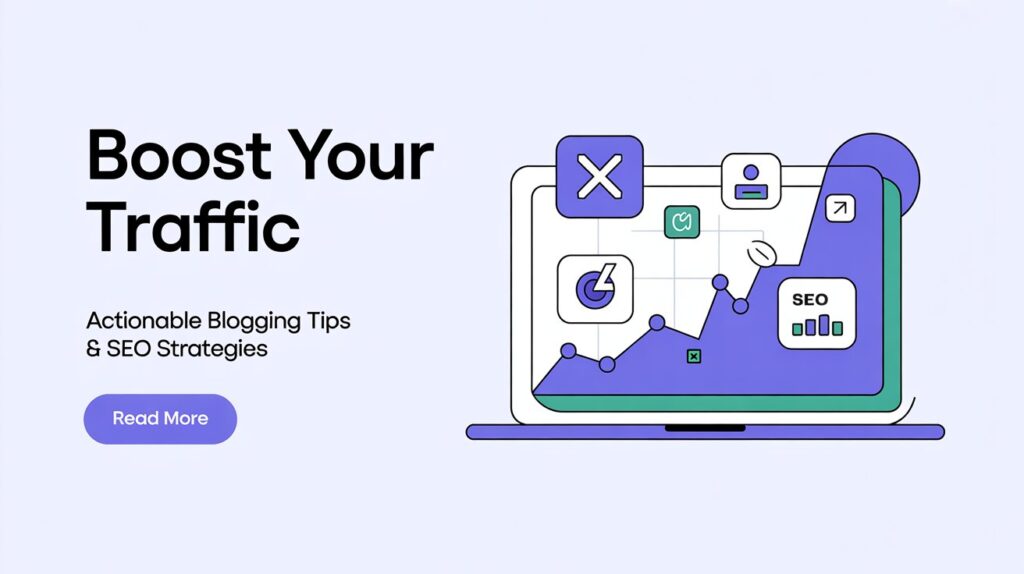
Proven Blogging Tips & SEO Strategies to Boost Your Traffic in 2025
Blogging continues to be one of the most powerful tools for building an online presence, driving traffic, and engaging audiences. However, in 2025, blogging is more strategic than ever. At OnPageGenius, we help brands optimize content for performance—and today, we’re revealing the top blogging tips to help you stand out in a crowded digital space.

Why Blogging Still Matters in 2025
Despite the rise of AI-generated content and video-first strategies, blogging remains critical because:
- Search engines still prioritize text-rich, informative content.
- Blogs establish authority, credibility, and organic reach.
- A single blog post can drive long-term SEO traffic and customer conversions.
If you’re serious about content success, apply these expert blogging tips today.
At a Glance: 16 Essential Blogging Tips
- Start with Keyword-Intent Research
- Choose a Clear Blogging Niche
- Identify Trending Topics and Reader Questions
- Write SEO-Friendly Headlines
- Create a Clear Blog Structure
- Focus on Original and Valuable Content
- Optimize for On-Page SEO
- Write for Humans First, Then Optimize
- Add Strong and Relevant CTAs
- Use Visuals to Enhance Engagement
- Ensure Mobile Optimization
- Update Old Content Regularly
- Interlink Your Blog Posts
- Focus on Readability and Formatting
- Repurpose Blog Content for Multiple Platforms
- Analyze Performance and Improve
1. Start with Keyword-Intent Research
Understanding what your audience is searching for and why is the foundation of successful blogging. Identify:
- Primary keywords relevant to your topic (like “blogging tips”)
- The intent behind searches (informational, navigational, or transactional)
- Common questions and related terms people use
This ensures that your blog answers the right queries and gets found on search engines.
2. Choose a Clear Blogging Niche
Don’t try to blog about everything. Pick a focused niche where you can provide value and become an authority. Ask yourself:
- What do I enjoy writing about?
- Is there a consistent audience for this niche?
- Can I offer unique insights or solutions?
The more specific your niche, the better your chances of building trust and ranking well.
3. Identify What’s Trending and What People Are Searching
Stay relevant by tapping into current trends and frequently asked questions. To find trending topics:
- Check popular queries related to your niche
- Observe conversations in online communities
- Follow news, seasonal patterns, and industry updates
Blogging on timely topics can boost visibility and engagement.
4. Write SEO-Friendly Headlines
Your headline is your blog’s first impression. Make it:
- Clear and concise
- Contain your main keyword (e.g., “blogging tips”)
- Emotionally engaging or curiosity-driven
Great headlines attract clicks and improve search visibility.
5. Create a Clear Blog Structure
Your blog should be easy to scan and digest. Use:
- Headings (H2, H3) to separate topics
- Short paragraphs (2–4 lines max)
- Bullet points and numbered lists
- Images and graphics for visual relief
A clean layout keeps readers engaged and helps search engines index your content properly.
6. Focus on Original and Valuable Content
Avoid copying or rehashing what’s already out there. Share:
- Personal insights or case studies
- Actionable advice your readers can apply
- Real examples and step-by-step instructions
Your content should solve a problem or answer a question clearly and originally.
7. Optimize for On-Page SEO
Good content needs proper optimization. Make sure to:
- Include the main keyword in the title, intro, and headings
- Write a compelling meta description
- Add alt text to images
- Use internal and external links naturally
- Keep your URL short and keyword-focused
These tweaks improve your chances of ranking on search engines.
8. Write for Humans First, Then Optimize
Search engines are smart, but humans read your content. So:
- Keep your tone conversational
- Use simple language
- Avoid keyword stuffing
- Focus on clarity and flow
Once your content reads naturally, go back and optimize for SEO.
9. Add Strong and Relevant CTAs (Calls to Action)
Guide your readers to take the next step. Add CTAs like:
- “Subscribe to the newsletter”
- “Download our free checklist”
- “Contact us for a free audit”
- “Read related posts”
Use CTAs in the middle and at the end of your post.
10. Use Visuals to Enhance Engagement
Images and media make your blog more engaging and shareable. Use:
- Relevant photos or graphics
- Custom illustrations or screenshots
- Charts and infographics
Always compress images to keep your page loading fast.
11. Ensure Mobile Optimization
Most readers will visit your blog on mobile devices. Make sure:
- Your blog layout is mobile-responsive
- Fonts are easy to read on small screens
- Buttons and CTAs are easily tappable
Mobile optimization is a ranking factor and a user-experience necessity.
12. Update Old Content Regularly
Don’t let your old blog posts die. Refresh them by:
- Updating stats and information
- Adding new insights or content sections
- Re-optimizing headlines and keywords
- Fixing broken links
Updated content can regain rankings and drive new traffic.
13. Interlink Your Blog Posts
Help both users and search engines by linking your blog posts together. Benefits include:
- Better site navigation
- Longer user session times
- Improved crawling and indexing
Use descriptive anchor text and link only where relevant.
14. Focus on Readability and Formatting
Make your blog easy to read with:
- Proper line spacing
- Consistent font style and size
- Highlighted quotes or tips
- Bold/italic text to emphasize key ideas
The better your blog reads, the longer visitors stay on the page.
15. Repurpose Blog Content for Multiple Platforms
Extend your blog’s life by repurposing it into:
- Social media posts or threads
- Email newsletters
- Downloadable guides or PDFs
- Video scripts or podcast episodes
One blog post can fuel content for weeks.
16. Analyze Performance and Improve
Use analytics tools to monitor:
- Pageviews and bounce rate
- Average time spent on page
- Conversion rates (e.g., subscribers or inquiries)
- Keyword rankings
Evaluate what works—and double down on it.

FAQs – Blogging Tips by OnPageGenius
Q1: How do I choose the best niche for my blog?
A1: Focus on topics you’re passionate about and where you can offer unique insights. Ensure there’s an audience searching for that niche by checking search trends and community discussions.
Q2: What is keyword-intent research and why is it important?
A2: Keyword-intent research involves finding the exact terms people use and understanding their purpose—whether to learn (informational), navigate (navigational), or buy (transactional). It ensures your content meets reader needs and ranks well.
Q3: How often should I update old blog content?
A3: Aim to review and refresh high-traffic or top-ranking posts every 3–6 months. Update statistics, add new examples, fix broken links, and reoptimize for current keywords.
Q4: What makes a headline “SEO-friendly”?
A4: An SEO-friendly headline includes your main keyword, clearly conveys the post’s benefit, and entices clicks with engaging or curiosity-driven language—all within about 60 characters.
Q5: How can I find trending topics in my niche?
A5: Monitor social media conversations, community forums, and search trend tools to see what questions and topics are gaining traction. Addressing these timely subjects can boost visibility.
Q6: Why is mobile optimization critical for blogs?
A6: Over half of web traffic comes from mobile devices. Mobile-responsive design and readable formatting improve user experience and are ranking factors for search engines.
Q7: What types of visuals work best in blog posts?
A7: Use relevant images, custom graphics, infographics, charts, and screenshots that illustrate key points. Ensure they’re optimized for fast loading and include descriptive alt text.
Q8: How do I measure my blog’s success?
A8: Track metrics like pageviews, time on page, bounce rate, conversion rate (subscriptions or inquiries), and keyword ranking improvements. Use these insights to refine your strategy.
Conclusion
Blogging in 2025 is about being intentional, strategic, and human-focused. By applying these blogging tips, you’ll not only rank better but also build a loyal and engaged audience.
Whether you’re starting a blog or refining your content strategy, these proven techniques will help you create better content and grow sustainably.

